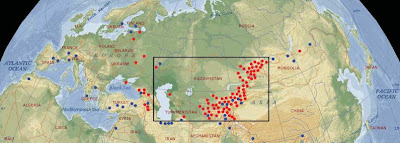 DNA barcoding Central Asian butterflies: increasing geographical dimension does not significantly reduce the success of species identification
DNA barcoding Central Asian butterflies: increasing geographical dimension does not significantly reduce the success of species identificationMolecular Ecology Resources (2009)
VLADIMIR A. LUKHTANOV,*† ANDREI SOURAKOV,‡ EVGENY V. ZAKHAROV§ and PAUL D. N. HEBERT§
*Department of Karyosystematics, Zoological Institute of Russian Academy of Science, Universitetskaya nab. 1, 199034 St. Petersburg, Russia, †Department of Entomology, St. Petersburg State University, Universitetskaya nab. 7/9, 199034 St. Petersburg, Russia, ‡McGuire Center for Lepidoptera and Biodiversity, Florida Museum of Natural History, University of Florida, Gainesville, FL 32611, USA, §Biodiversity Institute of Ontario, University of Guelph, Guelph, ON, Canada N1G 2W1
動物方面的DNA條碼(DNA barcoding)研究經常使用粒線體COI作為物種內的鑑定標記,在過去的研究中此方式表現頗佳,因為典型的粒線體COI在種間的變異比種內的變異高出許多。然而,許多先前的研究只著眼於局部區域性的動物相,許多批評者認為基因條碼對於分布地區廣泛的物種鑑定可能效果較差,原因為:(1)許多較晚近分化出來的類群會被排除在局部區域分析之外,因為他們是異域種類;(2)由於基因條碼領域中不考慮地理變異,因此種內變異在地區性研究上可能被嚴重地低估。 本文作者檢驗353種中亞的蝴蝶以探討增加地理範圍如何影響基因條碼分析的解析度。結果發現,與晚近分化的同域類群相較,具地理區隔的類群或晚近分化出來的異域分布物種並未表現出較低的序列變異。雖然增加地理覆蓋範圍會大幅增加種內變異,使得兩個物種間的生物條碼距離縮短,但並不會降低使用Neighbor-Joining歸群方法時的物種鑑定。 包含更多族群的確會增加駢系的存在,但是並不妨礙種級的鑑定,因為駢系物種會因大量的序列分化而與他們的單系親戚分開。因此,作者認為本研究說明即使分類群來自廣大的地理分布範圍,DNA條碼仍然是一個有效的鑑定工具。
Abstract
DNA barcoding employs short, standardized gene regions (5’ segment of mitochondrial cytochrome oxidase subunit I for animals) as an internal tag to enable species identification. Prior studies have indicated that it performs this task well, because interspecific variation at cytochrome oxidase subunit I is typically much greater than intraspecific variation. However, most previous studies have focused on local faunas only, and critics have suggested two reasons why barcoding should be less effective in species identification when the geographical coverage is expanded. They suggested that many recently diverged taxa will be excluded from local analyses because they are allopatric. Second, intraspecific variation may be seriously underestimated by local studies, because geographical variation in the barcode region is not considered. In this paper, we analyse how adding a geographical dimension affects barcode resolution, examining 353 butterfly species from Central Asia. Despite predictions, we found that geographically separated and recently diverged allopatric species did not show, on average, less sequence differentiation than recently diverged sympatric taxa. Although expanded geographical coverage did substantially increase intraspecific variation reducing the barcoding gap between species, this did not decrease species identification using neighbour-joining clustering. The inclusion of additional populations increased the number of paraphyletic entities, but did not impede species-level identification, because paraphyletic species were separated from their monophyletic relatives by substantial sequence divergence. Thus, this study demonstrates that DNA barcoding remains an effective identification tool even when taxa are sampled from a large geographical area.
動物方面的DNA條碼(DNA barcoding)研究經常使用粒線體COI作為物種內的鑑定標記,在過去的研究中此方式表現頗佳,因為典型的粒線體COI在種間的變異比種內的變異高出許多。然而,許多先前的研究只著眼於局部區域性的動物相,許多批評者認為基因條碼對於分布地區廣泛的物種鑑定可能效果較差,原因為:(1)許多較晚近分化出來的類群會被排除在局部區域分析之外,因為他們是異域種類;(2)由於基因條碼領域中不考慮地理變異,因此種內變異在地區性研究上可能被嚴重地低估。 本文作者檢驗353種中亞的蝴蝶以探討增加地理範圍如何影響基因條碼分析的解析度。結果發現,與晚近分化的同域類群相較,具地理區隔的類群或晚近分化出來的異域分布物種並未表現出較低的序列變異。雖然增加地理覆蓋範圍會大幅增加種內變異,使得兩個物種間的生物條碼距離縮短,但並不會降低使用Neighbor-Joining歸群方法時的物種鑑定。 包含更多族群的確會增加駢系的存在,但是並不妨礙種級的鑑定,因為駢系物種會因大量的序列分化而與他們的單系親戚分開。因此,作者認為本研究說明即使分類群來自廣大的地理分布範圍,DNA條碼仍然是一個有效的鑑定工具。
Abstract
DNA barcoding employs short, standardized gene regions (5’ segment of mitochondrial cytochrome oxidase subunit I for animals) as an internal tag to enable species identification. Prior studies have indicated that it performs this task well, because interspecific variation at cytochrome oxidase subunit I is typically much greater than intraspecific variation. However, most previous studies have focused on local faunas only, and critics have suggested two reasons why barcoding should be less effective in species identification when the geographical coverage is expanded. They suggested that many recently diverged taxa will be excluded from local analyses because they are allopatric. Second, intraspecific variation may be seriously underestimated by local studies, because geographical variation in the barcode region is not considered. In this paper, we analyse how adding a geographical dimension affects barcode resolution, examining 353 butterfly species from Central Asia. Despite predictions, we found that geographically separated and recently diverged allopatric species did not show, on average, less sequence differentiation than recently diverged sympatric taxa. Although expanded geographical coverage did substantially increase intraspecific variation reducing the barcoding gap between species, this did not decrease species identification using neighbour-joining clustering. The inclusion of additional populations increased the number of paraphyletic entities, but did not impede species-level identification, because paraphyletic species were separated from their monophyletic relatives by substantial sequence divergence. Thus, this study demonstrates that DNA barcoding remains an effective identification tool even when taxa are sampled from a large geographical area.

沒有留言:
張貼留言